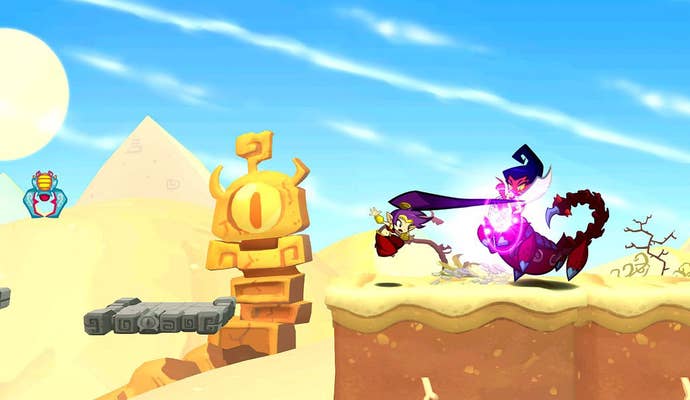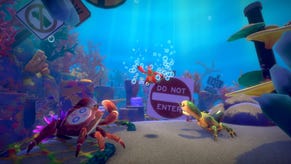Shantae's Inside Story
Pirate's Curse director Matt Bozon fields our questions about game design, sexy ladies, and how to build a better Metroid.
This article first appeared on USgamer, a partner publication of VG247. Some content, such as this article, has been migrated to VG247 for posterity after USgamer's closure - but it has not been edited or further vetted by the VG247 team.
I've always enjoyed the Shantae series, but the latest chapter — Shantae and the Pirate's Curse, released for 3DS eShop last week — proved to be particularly good. Director Matt Bozon was kind enough to field some questions about the creative process behind the series.
USgamer: In terms of scope, what was your goal with Pirate's Curse compared to the previous games in the Shantae series? Risky's Revenge was more of a bite-sized episode than the original game, for example.
Matt Bozon: It's huge! There are many ways to measure a game, but whether you're counting up hours, bosses, chapters, number of labyrinths, or story arcs this game is roughly the size of the original Shantae retail game and the DSiWare download game combined. There's no stretching of the content for the sake of artificial game length either — it's a fast paced game right up to the end. There's also an unlockable second mode and alternate endings. We're hoping players will be coming back for several years, playing it again and again.

USG: A big part of Shantae games to date has been her ability to transform. But here, Shantae has lost her genie powers. How did you change the game design to reflect that?
MB: This was intentional, to keep the series from becoming too formulaic by game number three. We're bringing back belly dancing in a big way for our HD Kickstarter game "Half-Genie Hero." But Pirate's Curse is a very different animal, using Metroid style conventions that combine weapons with agility. Getting a Cannon for example doesn't only let you destroy a single barrier, move on, and put the cannon away for later! Not at all! Like Metroid, that Cannon becomes an integral part of your move set and drastically changes how you'll play from that point on. We have a handful of magical items too. But it's really more of a "pirate gadget" adventure.
USG: The Shantae games focus heavily on female characters, all with a pretty heavy emphasis on sex appeal (cute sex appeal, but still). Has the recent focus on the treatment of women in games industry had any impact on your approach to this game?
MB: We've always featured strong female leads in our original games, and I believe that each one has merit that goes beyond their being physically attractive (though they often are). We've been featuring solo female characters since 1994, starting with Shantae. The concept of fighting monsters in her own cute and sexy way by belly dancing and whipping them with her hair hasn't changed. Fictional women aside, I've been fortunate enough to work alongside incredible programmers, producers, animators, writers, voice actors and musicians, and yep – lots of are ladies and some are moms, too! Shantae's creator included!

USG: Given the flexibility of digital distribution across all the different viable platforms available today, why limit the game just to Nintendo platforms?
MB: Well, with this being the third and final game in the original story arc, I really wanted it to end on a Nintendo handheld since that's where it all began. We've been slowly porting the previous Shantae games to other platforms and I'm sure we'll go down those avenues with Pirate's Curse later on. But for right now the 3DS version is our focus, with the Wii U port arriving this winter. Half-Genie Hero will be the first Shantae game to be designed for multi-platform.
USG: On the flip side of that, the entire Shantae trilogy will be playable on 3DS. Has there been any thought to creating a trilogy compilation for other platforms?
MB: We've thought about it. But the three games were all developed by different teams in different engines over the course of 2 decades. It presents a considerable technical challenge. At one point I realized that the worlds of the previous two games could be nested inside the world of Pirate's Curse. That would be a massive undertaking one day, but could be fun!

USG: The Shantae series has had a lot of ups and downs, with several planned versions never quite seeing the light of day. How do the games that manage to run the gauntlet fit with your grand vision of the series? Does Pirate's Curse express all the ideas and aspirations you had for the sequels that never saw the light of day?
MB: No — the number of Shantae concepts that gained limited traction, but have never seen the light of day are about 10 to 1. Each game concept has been completely different. Some general ideas, like characters and locations do carry over, but there are many more left on the drawing board. Our GameCube game took place entirely on a river. Our PS1 game was a diorama view 3D game, and our PS2 Shantae was free-roaming. Our DS game which never moved beyond prototype was a spline-scroller.

We've had a love-letter concept for every gaming platform under the sun... too many ideas to fit into a single game. The is a reason that the ideas don't carry over. That's because WayForward adheres to a "bottom up" approach to game design. The game's mechanics are designed first, typically before the characters and scenarios are created. So while some general ideas survive the transition to the next game, often the core gameplay – the big ideas- are left behind.
USG: So, bonus question. Shantae has always been compared, to various degrees, to the Metroid games. That series always sets players going through the same motions to power-up Samus the same way, which has become formulaic. With Pirate's Curse, you've actually broken from the series formula. So! If you were given the reins for the next Metroid game, how would you apply what you've learned with this game to freshen things up?
MB: Wow, ok! Yes directing a Metroid game is the tip top of my bucket list, one step above Mega Man, one step above Contra. And I would love to hit two out of three of those goals somehow. Shantae has some Metroid-taught lessons on display, but it's really not a true Metroid. I would not want to see Metroid go in a story driven direction, or have rooms dedicated to one-off puzzles like Shantae (really, that's more of a Zelda thing), or lengthy dialogue delivery in order to earn a few yuks. The silent show-don't-tell of Super Metroid is just incredible, and really hasn't been duplicated since
I would want to put game pacing and precision controls at the top and go from there, creating new moves and ways to use them. And hey, what if there was no Samus? Gasp! Right? Has anyone else encountered a Metroid and lived to tell about it? What does Kraid do after hours? Have he and Ridley ever met? Does Mother Brain have kids? Is that brain from Life Force the father? So many brains...







.jpg?width=291&height=164&fit=crop&quality=80&format=jpg&auto=webp)
